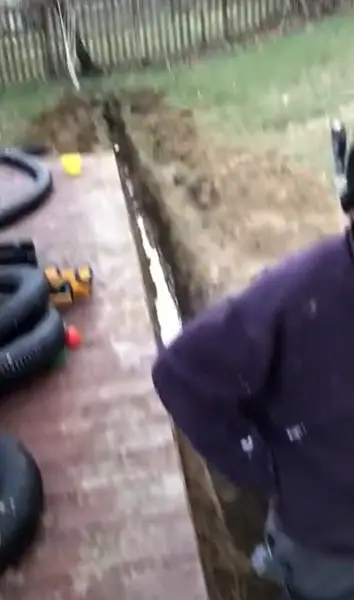Are you tired of battling perpetual dampness in your home? Enter the French drain: the unsung hero in the fight against moisture intrusion and foundation woes. Say goodbye to soggy basements and hello to a sturdy, dry abode. Let’s delve into the world of French drains, why they’re indispensable, and how they ensure a moisture-free yard and home.
Table of Contents
Key Insights
Before we dive into the details, let’s arm ourselves with some invaluable wisdom:
- Early Intervention: Don’t overlook water accumulation around your home—it’s a harbinger of potential disaster. Address it promptly to avert future crises.
- Seek Professional Guidance: While DIY projects hold allure, consulting experts provides invaluable insights tailored to your property’s unique needs.
- Commit to Maintenance: When installed properly, sod covered French drains no not need any maintenance for many years. French drains that have exposed gravel will need more upkeep to keep it looking new. That is because dirt will accumulate and plants will start to grow. Treat your French drain like a prized possession; regular upkeep ensures optimal functionality and longevity.

Understanding French Drains
Imagine a trench filled with gravel and a perforated pipe—a French drain at work, diverting water away from your home’s foundation. Its purpose? To safeguard against moisture-induced damage and maintain structural integrity to a home’s foundation.
Key Components:
- Perforated Pipe: The core element, allowing water to enter and to drain away to the discharge location. You can buy pipes with filter fabric on them.
- Gravel or Rock Fill: Facilitates water flow towards the pipe, ensuring efficient drainage into the pipe.
- Filter Fabric: Acts as a protective barrier, preventing soil intrusion into the pipe or the gravel and maintaining the drain’s efficacy. You can buy pipes with filter fabric on them.

Benefits of French Drains:
- Basement Flood Prevention: Bid farewell to unwanted indoor swimming pools—French drains keep basements dry and belongings safe.
- Soil Erosion Control: Protect your property from the erosive forces of water, preserving landscape integrity.
- Foundation Preservation: Mitigate water-induced foundation damage, ensuring structural stability and longevity.
Assessing the Need for a French Drain:
Observe your surroundings—are water puddles becoming a regular sight? Is your basement feeling excessively damp? Don’t overlook cracks in your foundation. Consult professionals to determine if a French drain is the solution your home requires.
Installing a French Drain: Step by Step
- Site Assessment: Identify problematic areas and plan the drain’s route to optimize water diversion.
- Excavation: Dig trenches of suitable dimensions, tailored to your property’s requirements. The trench should slope 1/4 inch for each foot of travel towards the discharge point.
- Pipe and Gravel Installation: Lay landscape filter fabric in the trench. With extra fabric sticking outside of the trench for the time being. Then place some gravel on the fabric in the trench and lay in the perforated pipe. Add more gravel to cover the pipe. Pull the extra fabric over the top of the gravel.
- Soil Covering and Restoration: Conceal the drain with soil and sod, restoring the landscape to its original state.
- Heavy Duty and High Strength Material: Features 6oz tough and durable density, PP non-woven, 350N tensile strength. Our Woven Geotextile Fabric features erosion-proof, damp-proof, tear-proof, and durable material compared with other woven ground covers.
- Exclusive Permeability & Soil-Friendly: This is not normal landscape fabric!!!! This is for major construction erosion control. You use this under concrete or pavement! It does allow drainage. You can use this on retainer walls and walk paths, but it is not its intended purpose. The purpose of this material is for heavy loads and high traffic. It is not a weed-stop.
- Widely Usage: Towallmark can help you deal with many projects where you need to make Drainage, Separation, Filtration. Perfect for French Drain, Erosion Control, Driveway Underlayment, RipRap Channels, Retaining walls and other construction projects.
- Easy to Install and Setup: Our 4ft x 50ft Geotextile fabric is super easy to carry, install or cut into single piece or exact dimensions, just roll down and put it in the preferred area.
- Made to last: The material will serve you for at least 30 years with proper use. The main rule is to avoid direct sunlight. If use it as a ground cover or weed barrier please buried it with 1/4 foot of mulch or gravel.
Maintenance and Care
Depending on how much and how often water runs to the French drain there may be times when the sod above the French drain will be dry and brownish compared to the rest of the yard. The opposite can be true also, The trench area can look green while the rest of the yard is brownisg from being too dry.
Without filter fabric, the gravel and drain pipe will eventually fill with dirt. Using filter fabric should provide many years of no maintenance.
However, iron bacteria can fill the pipe with a reddish-orangish slime called iron ochre that should be removed before it hardens. So, it would be a good idea to have an access point to the drain pipe.
Regularly inspect your French drain for signs of clogging or damage. Promptly address any issues that arise. If there is an inlet grate in the yard for water to enter the drain tile be sure to remove leaves, sticks etc that may collect on the grate.
Cost Considerations
Factors influencing costs include the area’s size, excavation depth, pipe quality, and potential long-term savings. Investing in premium materials and professional installation yields substantial benefits in terms of durability and effectiveness.
If the collected water must be raised in order for it to be released at the designated place, then a sump pump will be needed. That will require electrical service to the sump pump location.
In many situations the French drain can dump the collected water into a dry well.
- COLLECT, DETAIN, AND INFILTRATE EXCESS WATER: Puts excess water back into the ground; the Flo-Well Dry Well is ideal for residential and commercial locations such as yards, playgrounds, golf courses, wash-down areas, rain gardens and bioswales
- HOW TO INSTALL: Connect to 4 in. Sewer and Drain (S&D) Pipe through top cover knockout; 12 side-panel knockout points connect to 4 in. S&D and Sch. 40 Pipes; Can be buried or stacked up to 8 ft. deep and supports pedestrian traffic including lawn tractors
- GRAVEL-FREE ALTERNATIVE: Unlike a traditional dry well that requires filling an large hole with heavy stone and gravel, the Flo-Well Dry Well only needs a small amount of gravel at the base to prevent scouring and provides 250% more detention volume
- USE ONE OR MANY: The Flo-Well Dry Well works as a stand alone product and can be used in multiples; units can be stacked up to 4 high or side-by-side 18 in. apart
- INCLUDES: 3 side panels and top cover, unassembled; open bottom allows water to seep into gravel and ground below; bottom panel sold separately to provide a base for a sump pump if desired
DIY vs. Professional Installation
While DIY projects offer cost savings and learning opportunities, they entail inherent risks. Professional installation ensures customized solutions, efficiency, and peace of mind with warranties and assurances.
In Conclusion
The French drain emerges as the unsung hero in the battle against moisture intrusion and foundation instability. Whether entrusting the task to professionals or embarking on a DIY journey, prioritize a dry, sturdy, and happy home. Stay vigilant for signs of water-related issues, and remember—prevention is the cornerstone of a moisture-free future. Cheers to a home fortified against the perils of water! For further information: LSU Ag Center

Author at Best Sump Pumps
The first time I helped to install a drain tile and basement sump pump system was 1978.
Since then I have worked for a city water utility where I worked with and maintained pumps.
My rental properties and personal homes all needed sump pumps.
As a modular home dealer/builder, those new homes needed sump pumps.
I put that experience to good use by providing reliable, useful, and practical advice on buying, using, and maintaining sump pumps.


